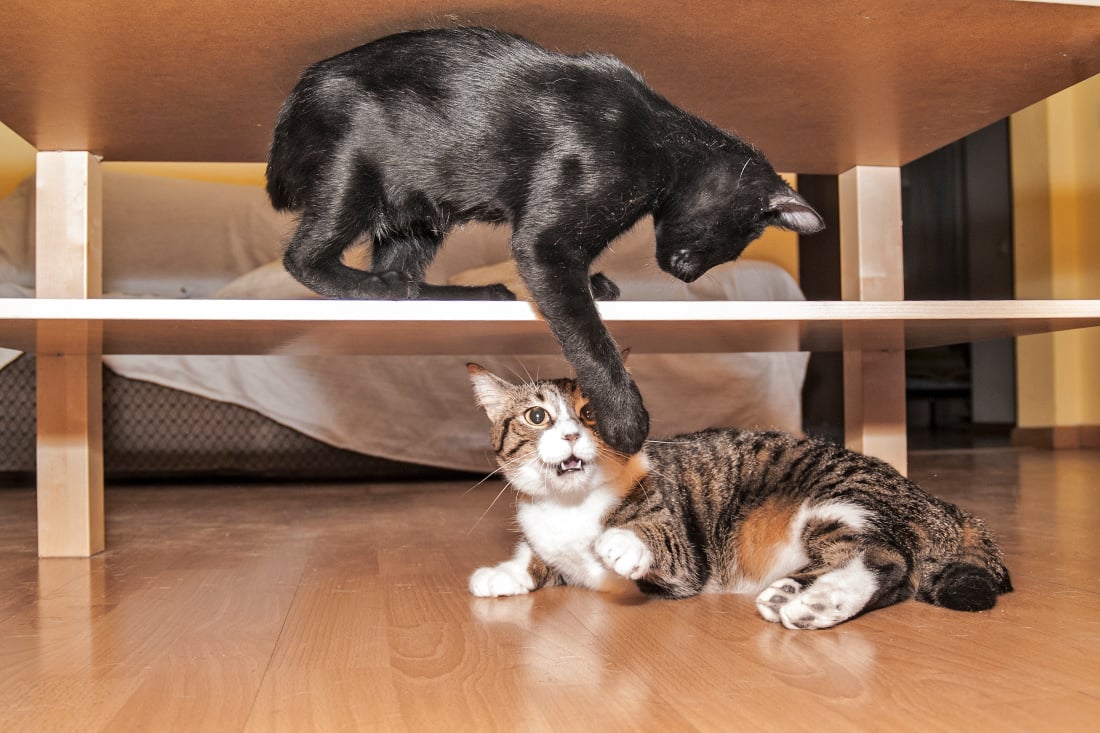Key Takeaways
- Cats are inherently territorial so introducing a new feline can be complicated.
- You can slowly ease a new kitty into the home to avoid upsetting the current resident.
- Create a separate space for a new cat, so both cats feel like they have their own home-base.
Bringing a new cat into your home is a tricky task in and of itself. You’ve got some cat-proofing to do, a few behavioral habits to curb, and an adjustment period for everyone else already living in the home. This becomes a bit more complicated when introducing a new cat to an existing feline resident who’s already quite comfortable with the status quo.
While some cats are laid back enough that this change doesn’t greatly affect them, you’ll find that many cats don’t take too kindly to the change since they’re inherently territorial. The good news is that with time, patience, and purposeful introductions, you can make the cat introduction process a smooth one. Below we’ve provided you with some tips, tricks, and advice to do just that.
One Week Out: Introduce the New Cat’s Scent
Cats are very much “scent focused,” and it’s important to remember this throughout the introduction process. In some scenarios, it’s possible to introduce your new cat’s scent into your home before actually bringing said feline into the house. A well-loved blanket, cushion, or toy works perfectly for this. Simply bring it into your home a week or two before the new cat arrives (or as soon as you’re able) and allow your other feline to interact with the object. This slow approach will help ease your cat before the big change.
The Day Before/Of: Create a Designated Space for Your New Cat
Keeping in line with a slow introduction, we highly recommend designating a room or small space for the new cat to hang out for the first week it’s at home. It’s good if the two felines can hear and smell each other, but they shouldn’t be able to see each other. This allows the new cat to feel like they have a territorial home-base of their own, and it allows your existing cat to get used to the idea of another feline in the house without feeling fully affronted. Make sure this space is comfortable and has all the necessities, including food, water, litter, scratcher, a cozy place (or two) to sleep, and a place to “hide” (such as a box or covered sleeper).
Two Days In: Swap Scents & Spaces
After your cat has been home for a day or two you can introduce each cat to the other’s scent. There are a few ways to do this. One is to rub a towel or sock over each cat and then allow the other feline to interact with the pheromone-infused item at their leisure. Another option is to let each cat interact with the other cat’s space (without actually interacting with or seeing each other). We recommend putting your new cat into another room, bringing the existing cat into your new cat’s designated space, and then letting the new cat out to explore the rest of the house for a few hours. You can repeat this daily.
Five Days In: Build Positive Associations
After about five to seven days, depending on how receptive each cat is, start building positive associations with the other cat’s scent and presence. Play games with each feline, or give them yummy treats, in front of the door. You can even attempt to set up a cozy spot for the other to sleep near the door, or feed each by the door. If they seem resistant or on-edge, move a few feet away from the door and get closer day by day.
One Week In: Allow the Cats to See Each Other
If everything seems to be going well, you can finally allow each cat to lay eyes on the other. Again, doing this gradually is key. We recommend using a screen door, baby gate, or a pet gate (which is often higher and better suited for cats given their ability to jump high). Follow your instincts here. If one or both seems very aggressive or on-edge, then only allow them to visually interact for short periods of time. You can continue building positive associations with each other by playing, feeding, and allowing them to sleep as close as they feel comfortable to the door.
10 Days In: The Face-to-Face Meet
At about a week-and-a-half in — if all is going well — advance to the final stage of introducing a new cat with a face-to-face meeting. At this stage, you shouldn’t expect them to get along swimmingly. They may hiss at each other, ignore each other, or even feel intimidated and go into hiding. Go slowly here by allowing face-to-face interaction for a few hours a day, then half the day, then the majority of the day, and finally all day/night. Continue to keep food, water, litter, and bedding separate.
Over time, your kitties will wander around the house at least accepting the other’s presence. Keep in mind that it may take months (even up to a year) for each to feel comfortable around the other. However, as long as they feel like they have a space of their own, this will help ease tension. In some cases, and when personalities mesh perfectly, new cats can become good friends. This is one of those situations where time will be the ultimate tell, and easing them into the process as we’ve outlined above may very well improve their chances of a solid friendship.






